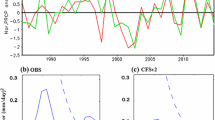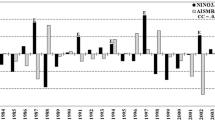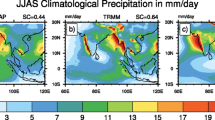Abstract
Interannual variability of the Indian Summer Monsoon Rainfall (ISMR) is modulated by Sea Surface Temperature (SST) anomalies over Indo-Pacific Oceans, especially by the El Niño Southern Oscillation (ENSO). In general, coupled models used for seasonal prediction overestimate the correlation between ENSO and ISMR compared to observations. By analysing the observational data from 1982 to 2017, this study shows that the relationship between ENSO and ISMR is weak during August compared to the other months of the summer monsoon season (June, July, and September). This weak association between ENSO and ISMR during August is due to an increase in the synoptic variability. Thus, the effect of large-scale flow dominated by ENSO is suppressed by the formation of a synoptic system in the Bay of Bengal (BoB), making ENSO-ISMR relation feeble in August. The data analysis of various coupled models shows that all models underestimate synoptic variability, due to which simulated ENSO-ISMR relation is overestimated during August. Coupled model exhibit strong biases in relative humidity and cyclonic circulation over the northern BoB hence underestimating the synoptic variability.



taken from Sikka (2006), data is available from 1984 to 2003. GPCP rainfall data is available from Oct 1996. Thus, the data used is from 1997 to 2003.(values are given in percentage). Similarly, MMCFS percentage contribution of LPS days rainfall to seasonal mean rainfall in June (f), July (g), August (h), September (i) and JJAS (j)





Similar content being viewed by others
Availability of data and material
The datasets generated during and/or analysed during the current study are available from the corresponding author (surya@tropmet.res.in) on reasonable request.
Code availability
Code available upon request to the corresponding author.
References
Ajayamohan RS, Rao SA (2008) Indian Ocean dipole modulates the number of extreme rainfall events over india in a warming environment. J Meteorol Soc Japan Ser II 86:245–252. https://doi.org/10.2151/jmsj.86.245
Ashok K, Guan Z, Yamagata T (2001) Impact of the Indian Ocean dipole on the relationship between the Indian monsoon rainfall and ENSO. Geophys Res Lett 28:4499–4502. https://doi.org/10.1029/2001GL013294
Ashok K, Guan Z, Yamagata T (2003) A Look at the Relationship between the ENSO and the Indian Ocean Dipole. J Meteorol Soc Japan Ser II 81:41–56. https://doi.org/10.2151/jmsj.81.41
Ashok K, Guan Z, Saji NH, Yamagata T (2004) Individual and combined influences of ENSO and the Indian Ocean dipole on the Indian Summer Monsoon. J Clim 17:3141–3155. https://doi.org/10.1175/1520-0442(2004)017%3c3141:IACIOE%3e2.0.CO;2
Banzon V, Smith TM, Chin TM et al (2016) A long-term record of blended satellite and in situ sea-surface temperature for climate monitoring, modeling and environmental studies. Earth Syst Sci Data 8:165–176. https://doi.org/10.5194/essd-8-165-2016
Boschat G, Terray P, Masson S (2012) Robustness of SST teleconnections and precursory patterns associated with the Indian summer monsoon. Clim Dynam 38(11):2143–2165
Charney JG, Shukla J (1981) Predictability of monsoons. In: Lighthill J, Pearce RP (eds) Monsoon dynamics. Cambridge University Press, Cambridge, pp 99–110
Chattopadhyay R, Rao SA, Sabeerali CT et al (2016) Large-scale teleconnection patterns of Indian summer monsoon as revealed by CFSv2 retrospective seasonal forecast runs. Int J Climatol 36:3297–3313. https://doi.org/10.1002/joc.4556
Chaudhari HS, Pokhrel S, Mohanty S, Saha SK (2013) Seasonal prediction of Indian summer monsoon in NCEP coupled and uncoupled model. Theor Appl Climatol 114:459–477. https://doi.org/10.1007/s00704-013-0854-8
Ek MB, Mitchell KE, Lin Y et al (2003) Implementation of Noah land surface model advances in the National Centers for Environmental Prediction operational mesoscale Eta model. J Geophys Res Atmos. https://doi.org/10.1029/2002JD003296
Gadgil S (2012) Seasonal prediction of the Indian summer monsoon: science and applications to Indian agriculture. In: ECMWF seminar on seasonal prediction, pp 3–7
Gill EC, Rajagopalan B, Molnar P (2015) Subseasonal variations in spatial signatures of ENSO on the Indian summer monsoon from 1901 to 2009. J Geophys Res Atmos 120:8165–8185. https://doi.org/10.1002/2015JD023184
Goswami BN, Ajayamohan RS, Xavier PK, Sengupta D (2003) Clustering of synoptic activity by Indian summer monsoon intraseasonal oscillations. Geophys Res Lett. https://doi.org/10.1029/2002GL016734
Goswami BB, Deshpande M, Mukhopadhyay P et al (2014) Simulation of monsoon intraseasonal variability in NCEP CFSv2 and its role on systematic bias. Clim Dyn 43:2725–2745. https://doi.org/10.1007/s00382-014-2089-5
Griffies SM, Harrison MJ, Pacanowski RC, Rosati A (2004) A Technical Guide to MOM4. NOAA/Geophysical Fluid Dynamics Laboratory
Heo K-Y, Ha K-J, Yun K-S et al (2014) Methods for uncertainty assessment of climate models and model predictions over East Asia. Int J Climatol 34:377–390. https://doi.org/10.1002/joc.3692
Huffman GJ, Adler RF, Bolvin DT, Gu G (2009) Improving the global precipitation record: GPCP Version 2.1. Geophys Res Lett. https://doi.org/10.1029/2009GL040000
Huffman GJ, Bolvin DT, Adler RF (2016) GPCP version 1.2 one-degree daily precipitation data set. Research Data Archive at the National Center for Atmospheric Research, Computational and Information Systems Laboratory, Boulder
Hunt KMR, Fletcher JK (2019) The relationship between Indian monsoon rainfall and low-pressure systems. Clim Dyn 53:1859–1871. https://doi.org/10.1007/s00382-019-04744-x
Hunt KMR, Turner AG et al (2016) On the structure and dynamics of Indian Monsoon Depressions. Mon Weather Rev. https://doi.org/10.1175/MWR-D-15-0138.1
Hurley JV, Boos WR (2015) A global climatology of monsoon low-pressure systems. Q J R Meteorol Soc 141:1049–1064. https://doi.org/10.1002/qj.2447
Ihara C, Kushnir Y, Cane MA (2008) July droughts over Homogeneous Indian Monsoon region and Indian Ocean dipole during El Niño events. Int J Climatol 28:1799–1805. https://doi.org/10.1002/joc.1675
Kanamitsu M, Ebisuzaki W, Woollen J, Yang SK, Hnilo JJ, Fiorino M, Potter GL (2002) NCEP-DOE AMIP-II Reanalysis (R-2). Bull Am Meteorol Soc. https://doi.org/10.1175/BAMS-83-11-1631
Keshavamurthy RN, Asnani GC, Pillai PV, Das SK (2021) Some studies of the growth of monsoon disturbances. Mausam 29(1 & 2):232
Kim J, Park SK (2016) Uncertainties in calculating precipitation climatology in East Asia. Hydrol Earth Syst Sci 20:651–658. https://doi.org/10.5194/hess-20-651-2016
Kirtman BP, Min D, Infanti JM et al (2014) The North American multimodel ensemble: phase-1 seasonal-to-interannual prediction; phase-2 toward developing intraseasonal prediction. Bull Am Meteorol Soc 95:585–601. https://doi.org/10.1175/BAMS-D-12-00050.1
Kothawale DR, Kulkarni JR (2014) Performance of all-India southwest monsoon seasonal rainfall when monthly rainfall reported as deficit/excess. Meteorol Appl 21:619–634. https://doi.org/10.1002/met.1385
Krishna Kumar K, Hoerling M, Rajagopalan B (2005) Advancing dynamical prediction of Indian monsoon rainfall. Geophys Res Lett. https://doi.org/10.1029/2004GL021979
Krishnamurthy V, Ajayamohan RS (2010) Composite structure of monsoon low pressure systems and its relation to Indian rainfall. J Clim 23:4285–4305. https://doi.org/10.1175/2010JCLI2953.1
Kulkarni A, Kripalani R, Sabade S, Rajeevan M (2011) Role of intra-seasonal oscillations in modulating Indian summer monsoon rainfall. Clim Dyn 36:1005–1021. https://doi.org/10.1007/s00382-010-0973-1
Kumar KK, Rajagopalan B, Cane MA (1999) On the weakening relationship between the Indian Monsoon and ENSO. Science (80-) 284:2156 LP – 2159. https://doi.org/10.1126/science.284.5423.2156
Meera M, Suhas E, Sandeep S (2019) Downstream and In situ: two perspectives on the initiation of monsoon low-pressure systems over the Bay of Bengal. Geophys Res Lett 46:12303–12310. https://doi.org/10.1029/2019GL084555
Mooley DA, Shukla J (1987) Characteristics of the Westward—moving Summer monsoon low pressure systems over the Indian region and their relationship with the monsoon rainfall. Center for Ocean-Land-Atmosphere Studies, Calverton
Moorthi S, Arakawa A (1985) Baroclinic Instability with Cumulus heating. J Atmos Sci. https://doi.org/10.1175/1520-469(1985)042%3c2007:BIWCH%3e2.0.CO;2
Moorthi S, Pan H-L, Caplan P (2001) Changes to the 2001 NCEP operational MRF/AVN global analysis/forecast system. NWS Tech. Procedures Bulletin 484, [Available online at http://www.nws.noaa.gov/om/tpb/484.htm.] Accessed 21 Jan 2022
Moron V, Robertson AW, Pai DS (2017) On the spatial coherence of sub-seasonal to seasonal Indian rainfall anomalies. Clim Dyn 49:3403–3423. https://doi.org/10.1007/s00382-017-3520-5
Pillai PA, Rao SA, George G et al (2017) How distinct are the two flavors of El Niño in retrospective forecasts of Climate Forecast System version 2 (CFSv2)? Clim Dyn 48:3829–3854. https://doi.org/10.1007/s00382-016-3305-2
Pillai PA, Rao SA, Ramu DA et al (2018) Seasonal prediction skill of Indian summer monsoon rainfall in NMME models and monsoon mission CFSv2. Int J Climatol 38:e847–e861. https://doi.org/10.1002/joc.5413
Pillai PA, Rao SA, Srivastava A et al (2021) Impact of the tropical Pacific SST biases on the simulation and prediction of Indian summer monsoon rainfall in CFSv2, ECMWF-System4, and NMME models. Clim Dyn 56:1699–1715. https://doi.org/10.1007/s00382-020-05555-1
Prajeesh AG, Ashok K, Rao DV (2013) Falling monsoon depression frequency: A Gray-Sikka conditions perspective. Sci Reports 3(1):1–8
Praveen V, Sandeep S, Ajayamohan RS (2015) On the relationship between mean monsoon precipitation and low pressure systems in climate model simulations. J Clim 28:5305–5324. https://doi.org/10.1175/JCLI-D-14-00415.1
Rajagopalan B, Molnar P (2012) Pacific Ocean sea-surface temperature variability and predictability of rainfall in the early and late parts of the Indian summer monsoon season. Clim Dyn 39:1543–1557. https://doi.org/10.1007/s00382-011-1194-y
Rajeevan M, Pai DS (2007) On the El Niño-Indian monsoon predictive relationships. Geophys Res Lett. https://doi.org/10.1029/2006GL028916
Rajeevan M, Bhate J, Kale JD, Lal B (2006) High resolution daily gridded rainfall data for the Indian region: analysis of break and active monsoon spells. Curr Sci 91:296–306
Ramu DA, Sabeerali CT, Chattopadhyay R et al (2016) Indian summer monsoon rainfall simulation and prediction skill in the CFSv2 coupled model: Impact of atmospheric horizontal resolution. J Geophys Res Atmos 121:2205–2221. https://doi.org/10.1002/2015JD024629
Ramu DA, Chowdary JS, Ramakrishna SSVS, Kumar OSRUB (2018) Diversity in the representation of large-scale circulation associated with ENSO-Indian summer monsoon teleconnections in CMIP5 models. Theoret Appl Climatol 132:465–478. https://doi.org/10.1007/s00704-017-2092-y
Rao SA, Luo J-J, Behera SK, Yamagata T (2009) Generation and termination of Indian Ocean dipole events in 2003, 2006 and 2007. Clim Dyn 33:751–767. https://doi.org/10.1007/s00382-008-0498-z
Rao SA, Goswami BN, Sahai AK et al (2019) Monsoon mission: a targeted activity to improve monsoon prediction across scales. Bull Am Meteorol Soc 100:2509–2532. https://doi.org/10.1175/BAMS-D-17-0330.1
Saha K, Sanders F, Shukla J (1981) Westward propagating predecessors of monsoon depressions. Mon Weather Rev 109:330–343. https://doi.org/10.1175/1520-0493(1981)109%3c0330:WPPOMD%3e2.0.CO;2
Saha S, Nadiga S, Thiaw C et al (2006) The NCEP Climate Forecast System. J Clim 19:3483–3517. https://doi.org/10.1175/JCLI3812.1
Saha SK, Hazra A, Pokhrel S et al (2019) Unraveling the Mystery of Indian Summer Monsoon Prediction: Improved Estimate of Predictability Limit. J Geophys Res Atmos 124:1962–1974. https://doi.org/10.1029/2018JD030082
Saji NH, Goswami BN, Vinayachandran PN, Yamagata T (1999) A dipole mode in the tropical Indian Ocean. Nature 401:360–363. https://doi.org/10.1038/43854
Sandeep S, Ajayamohan RS, Boos WR, Sabin TP, Praveen V (2017) Decline and poleward shift in Indian summer monsoon synoptic activity in a warming climate. Proc Natl Acad Sci 115(11):2681–2686. https://doi.org/10.1073/pnas.1709031115
Sikka DR (2006) Study on the monsoon low pressure systems over the Indian Region and their relationship with drought and excess monsoon seasonal rainfall. Center for Ocean-Land-Atmosphere Studies, Center for the Application of Research on the Environment, Calverton
Sreejith OP, Panickal S, Pai S, Rajeevan M (2015) An Indian Ocean precursor for Indian summer monsoon rainfall variability. Geophys Res Lett 42:9345–9354. https://doi.org/10.1002/2015GL065950
Srivastava A, Rao SA, Rao DN et al (2017) Structure, characteristics, and simulation of monsoon low-pressure systems in CFSv2 coupled model. J Geophys Res Ocean 122:6394–6415. https://doi.org/10.1002/2016JC012322
Trenberth KE (1997) The definition of El Niño. Bull Am Meteorol Soc 78:2771–2778. https://doi.org/10.1175/1520-0477(1997)078%3c2771:TDOENO%3e2.0.CO;2
Trenberth KE, Christy JR, Hurrell JW (1992) Monitoring global monthly mean surface temperatures. J Clim 5:1405–1423. https://doi.org/10.1175/1520-0442(1992)005%3c1405:MGMMST%3e2.0.CO;2
Vishnu S, Boos WR, Ullrich PA, O’Brien TA (2020) Assessing historical variability of South Asian monsoon lows and depressions with an optimised tracking algorithm. J Geophys Res Atmos 125:e2020JD032977. https://doi.org/10.1029/2020JD032977
Webster PJ, Yang S (1992) Monsoon and Enso: selectively interactive systems. Q J R Meteorol Soc 118:877–926. https://doi.org/10.1002/qj.49711850705
Webster PJ, Moore AM, Loschnigg JP, Leben RR (1999) Coupled ocean-atmosphere dynamics in the Indian Ocean during 1997–98. Nature 401:356–360
Winton M (2000) A reformulated three-layer sea ice model. J Atmos Ocean Technol 17:525–531. https://doi.org/10.1175/1520-0426(2000)017%3c0525:ARTLSI%3e2.0.CO;2
Acknowledgements
IITM is a fully-funded institute under the Ministry of Earth Sciences, Govt. of India. The authors acknowledge the Director, IITM, for the support. NCAR is acknowledged for the software NCAR Command Language (NCL) version 6.4.0. The authors would also like to thanks anonymous reviewer whose suggestions helped to improve this manuscript.
Funding
Not applicable.
Author information
Authors and Affiliations
Contributions
RSD and SAR designed, analysed, and proposed the paper's methodology and prepared the manuscript. PAP, AS, MP, and DAR contributed to the paper's discussion and corrections.
Corresponding author
Ethics declarations
Conflicts of interest/Competing interests
None.
Additional information
Publisher's Note
Springer Nature remains neutral with regard to jurisdictional claims in published maps and institutional affiliations.
Appendix 1: low-pressure system tracking algorithm
Appendix 1: low-pressure system tracking algorithm
Studies like Hunt et al. (2016), Hurley and Boos (2015), Praveen et al. (2015), and Srivastava et al. (2017) have identified LPS in reanalysis data using a tracking algorithm. These studies use Mean Sea Level Pressure (MSLP) and vorticity in the algorithm. However, Model simulated MSLP may have bias, and vorticity can be noisy. Recently, Vishnu et al. (2020) have shown that stream function is an optimal variable to track LPS (Vishnu et al. 2020). Their work showed that the stream function of 850 hPa is less noisy and represents the complete non-divergent wind. Thus, this study uses stream function to identify the LPS system.
Procedure to identify the system:
Step 1: Search the system with minima in the stream function.
Step 2: Remove multiple systems within 5 degrees by retaining a low mslp.
Step 3: Ensure the system has relative humidity higher than 80% within 3 degrees of the system.
Step 4: Ensure the system exists for 24 h.
Step 5: Each system is assigned a number.
Rights and permissions
About this article
Cite this article
Das, R.S., Rao, S.A., Pillai, P.A. et al. Why coupled general circulation models overestimate the ENSO and Indian Summer Monsoon Rainfall (ISMR) relationship?. Clim Dyn 59, 2995–3011 (2022). https://doi.org/10.1007/s00382-022-06253-w
Received:
Accepted:
Published:
Issue Date:
DOI: https://doi.org/10.1007/s00382-022-06253-w




